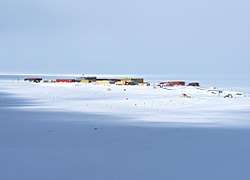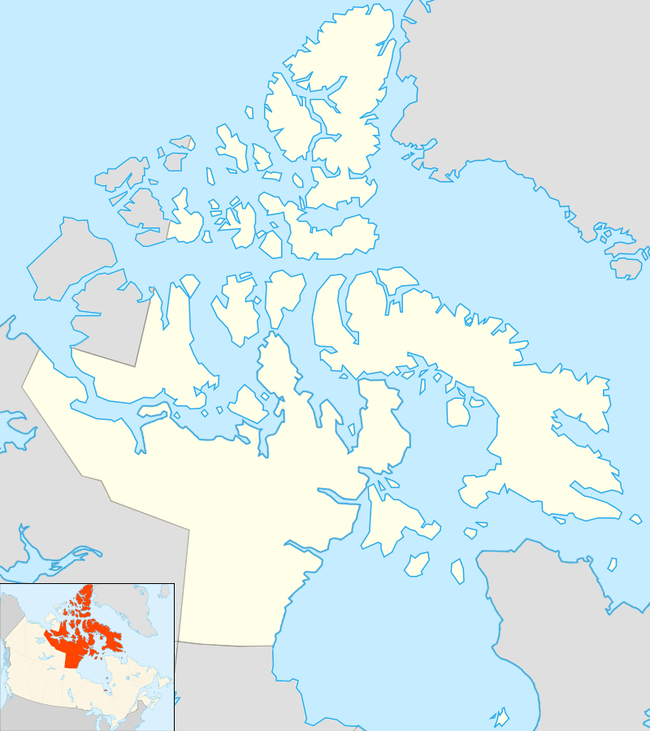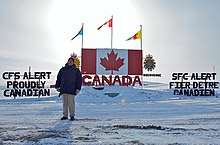CFS Alert
Canadian Forces Station Alert, also CFS Alert, is a Canadian Armed Forces signals intelligence intercept facility located in Alert, Nunavut, Canada, on the northeastern tip of Ellesmere Island.
CFS Alert | |
|---|---|
Canadian Forces Station | |
 View of the station from the south, May 2016 | |
| Etymology: Named for HMS Alert | |
| Motto(s): Inuit Nunangata Ungata (English: Beyond the Inuit Land) | |
 CFS Alert | |
| Coordinates: 82°30′05″N 62°20′20″W | |
| Country | Canada |
| Territory | Nunavut |
| Region | Qikiqtaaluk |
| Established | September 1, 1958 |
| Elevation | 30 m (100 ft) |
| Population (2016)[2] | |
| • Total | 62 |
| Time zone | UTC−5 (EST) |
| • Summer (DST) | UTC−4 (EDT) |
Located in the Qikiqtaaluk Region, Nunavut, it is the northernmost permanently inhabited place in the world.[3] It takes its name from HMS Alert, which wintered 10 km (6.2 mi) east of the present station off what is now Cape Sheridan, Nunavut in 1875–1876.[4] The entire population of Baffin, Unorganized, the Statistics Canada name for Qikiqtaaluk, is located here. As of the 2016 census the population was reported as 62, an increase of 1,140% over the 2011 census.[2]

History
Alert Wireless Station
Alert, then located in Canada's Northwest Territories, was first settled April 9, 1950, when the first staff for the Joint Arctic Weather Station (JAWS) arrived and began construction. Since the beginning of the JAWS project, the Canadian military had been interested in the establishment at Alert for several reasons: the JAWS facility extended Canadian sovereignty over a large uninhabited area which Canada claimed as its sovereign territory, and furthermore, its proximity to the Soviet Union made it of strategic importance. In fact, Alert is closer to Moscow (c. 2,500 mi [4,000 km]) than it is to Ottawa (c. 2,580 mi [4,150 km]). Thus, the possibility of using the site for intercepting radio signals was deemed to warrant a military presence.
In 1956, the Royal Canadian Air Force (RCAF), which was expanding its presence throughout the high Arctic with the construction of the Distant Early Warning Line radar network, established a building uphill from the Department of Transport's JAWS station to house "High Arctic Long Range Communications Research", or signals intelligence operations.
In 1957, Alert Wireless Station was conceived as an intercept facility to be jointly staffed by personnel from the Royal Canadian Navy (RCN) and the RCAF. Five additional buildings were constructed: a mess, three barracks/accommodations buildings, and a power house and vehicle maintenance building, in addition to the existing operations building, built in 1956. The operations building housed the radio intercept and cryptographic equipment. On September 1, 1958 control of the station was transferred from the RCAF to the Canadian Army and it officially began operations.
Canadian Forces Station Alert
The following decade saw a dramatic expansion of the station with a correspondingly greater number of personnel stationed there. The February 1, 1968 unification of the RCN, RCAF and Army to form the Canadian Armed Forces saw Alert Wireless Station change its name to Canadian Forces Station Alert (CFS Alert). Its personnel were no longer drawn from only the Air Force or Navy, but primarily from the Canadian Forces Communications Command.
At its peak, CFS Alert had upwards of 215 personnel posted at any one time. The station became a key asset in the global ECHELON network of the US-UK-CAN-AUS-NZ intelligence sharing alliance, with Alert being privy to many secret Soviet communications regarding land-based and sea-based ICBM test launches and many operational military deployments
The first military women to serve in Alert arrived in 1980 as part of the Canadian Forces' Women In Non-Traditional Roles study. After its completion in 1983, women were fully authorized to serve in all roles.[5] The first female commanding officer was Major Cathy Cowan, who took command in January 1996. The first female Station Warrant Officer (SWO), Master Warrant Officer Renee Hansen, was appointed in December 2017.[6]
Budget cuts to the Department of National Defence (DND) and Canadian Forces in 1994, and modernization of communications equipment, saw CFS Alert downsized to approximately 74 personnel by 1997–1998 when most radio-intercept operations were remotely controlled by personnel at CFS Leitrim. Remaining personnel are responsible for airfield operations, construction/engineering, food service, and logistical/administrative support. Only six personnel are now responsible for actual operations, and control of the facility was passed to DND's Information Management Group following the disbanding of CF Communications Command with force restructuring and cutbacks in the mid-1990s. Several of these personnel are likely also attached to DND's Communications Security Establishment.
With Canada's commitment to the global war on terrorism following the September 11, 2001 terrorist attacks in New York City and Washington, D.C., CFS Alert has received renewed and increased funding to expand its SIGINT capabilities. On April 1, 2009, the RCAF officially took responsibility for CFS Alert from Canadian Forces Information Operations Group (CFIOG).
Civilian contractor
As of 13 April 2006 the Canadian Broadcasting Corporation was reporting that the heating costs for the station had risen, in consequence of which the military were proposing to cut back on support trade positions by using private contractors.[7] By 2008, maintenance operations on station (including food and housekeeping services, vehicle maintenance, powerplant operation, and heating, electrical, and plumbing) had been transferred to a civilian contractor. The contract was initially awarded to Canadian Base Operators (CBO), a subsidiary of Black & McDonald. In 2012, the contract was won by Nasittuq, a subsidiary of ATCO.
Facilities and infrastructure
- Alert Airport
- Cold storage building
- Construction Engineering building
- Fire station
- Headquarters and Personnel Services (HAPS) building: Churchill Hall
- Living quarters: Chimo Hall, Ladner Hall, and Whitehorse Hall
- Main gym and curling rink
- Operations building: Polaris Hall
- Powerplants: Primary and backup
- Supply building
- Vehicle maintenance building
- Water treatment plant
See also
- Nanisivik Naval Facility 1,100 km (680 mi) south
- Drifting ice station (North Pole station)
- Amundsen–Scott South Pole Station
References
- Canada Flight Supplement. Effective 0901Z 16 July 2020 to 0901Z 10 September 2020.
- "2016 Community Profiles Csmbridg Bay". Retrieved March 28, 2017.
- "Alert, Nunavut". Government of Canada. Archived from the original on September 20, 2008. Retrieved August 9, 2008.
- A History of the Canadian Coast Guard and Marine Services Archived September 28, 2009, at the Wayback Machine
- "Canadian Forces Station Alert | 8 Wing | Royal Canadian Air Force". Archived from the original on September 24, 2015. Retrieved August 10, 2013.
- Brunet, Julie. "CFS Alert welcomes first female station warrant officer – The Maple Leaf". The Maple Leaf. Government of Canada. Retrieved February 8, 2018.
- "Costly fuel prompts cuts at northern military station". CBC News. Canadian Broadcasting Corporation. April 13, 2006. Retrieved August 9, 2008. article mirror
External links
| Wikimedia Commons has media related to CFS Alert. |
- CFS Alert (Canadian Forces)
- CFS Alert, J. Proc history page